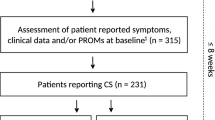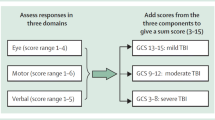Abstract
Background
Intracranial germ cell tumors (GCT) are more common in Asia than in the West, accounting for about 15% of brain tumors in Asian children. The survival rate for intracranial GCT is excellent, but there are concerns about the effects of radiotherapy on neuropsychological function and quality of life of patients.
Methods
Intracranial germ cell tumors (GCT) are more common in Asia than in the West, accounting for about 15% of brain tumors in Asian children. The survival rate for intracranial GCT is excellent, but there are concerns about the effects of radiotherapy on neuropsychological function and quality of life of patients. Intracranial GCT survivors in Hong Kong aged ≥ 6 years who received cranial irradiation in the past 15 years were recruited. Neurocognitive function and performance status were assessed by the Hong Kong Wechsler Intelligence scale and Karnofsky/Lansky performance scales (KPS), respectively. Quality of life was assessed using the Pediatric Quality of Life Inventory (PedsQL) Generic Core Scales. A chart review was performed for tumor characteristics and complications related to the tumor and its treatment.
Results
Twenty-five intracranial GCT survivors were recruited. Longer length of time since treatment was associated with lower IQ scores. Larger tumor size was associated with lower KPS scores. Hemiparesis, poor manual dexterity, and complications with multi-organ involvement were associated with significantly lower KPS scores. Higher irradiation dosage was associated with lower PedsQL physical scores.
Conclusions
The majority of GCT survivors had average intellectual functioning, satisfactory performance status and relatively good quality of life, except in the physical aspect. Comprehensive evaluation and long-term follow-up of GCT survivors are essential to provide timely support and improve long-term outcomes.

Similar content being viewed by others
References
Wong TT, Ho DM, Chang KP et al (2005) Primary pediatric brain tumors: statistics of Taipei VGH, Taiwan (1975–2004). Cancer 104(10):2156–2167
Central Brain Tumor Registry of the United States. Central Brain Tumor Registry of the United States (2006) http://www.cbtrus.org/index.html. Accessed 7 June 2018
Keene D, Johnston D, Strother D et al (2007) Epidemiological survey of central nervous system germ cell tumors in Canadian children. J Neurooncol 82(3):289–295
Khong PL, Leung LH, Fung AS et al (2006) White matter anisotropy in post-treatment childhood cancer survivors: preliminary evidence of association with neurocognitive function. J Clin Oncol 24(6):884–890
Sterkenburg AS, Hoffmann A, Gebhardt U, Warmuth-Metz M, Daubenbuchel AM, Muller HL (2015) Survival, hypothalamic obesity, and neuropsychological/psychosocial status after childhood-onset craniopharyngioma: newly reported long-term outcomes. Neuro-oncology 17(7):1029–1038
Cohen LE (2016) Update on childhood craniopharyngiomas. Curr Opin Endocrinol Diabetes Obes 23(4):339–344
Martens T, Rotermund R, Zu Eulenburg C, Westphal M, Flitsch J (2014) Long-term follow-up and quality of life in patients with intracranial germinoma. Neurosurg Rev 37(3):445–450; discussion 451
Phi JH, Cho BK, Kim SK et al (2010) Germinomas in the basal ganglia: magnetic resonance imaging classification and the prognosis. J Neurooncol 99(2):227–236
Liang SY, Yang TF, Chen YW et al (2013) Neuropsychological functions and quality of life in survived patients with intracranial germ cell tumors after treatment. Neuro-oncology 15(11):1543–1551
Mabbott DJ, Monsalves E, Spiegler BJ et al (2011) Longitudinal evaluation of neurocognitive function after treatment for central nervous system germ cell tumors in childhood. Cancer 117(23):5402–5411
Sands SA, Kellie SJ, Davidow AL et al (2001) Long-term quality of life and neuropsychologic functioning for patients with CNS germ-cell tumors: from the First International CNS Germ-Cell Tumor Study. Neuro-oncology 3(3):174–183
Mulhern RK, Merchant TE, Gajjar A, Reddick WE, Kun LE (2004) Late neurocognitive sequelae in survivors of brain tumours in childhood. Lancet Oncol 5(7):399–408
Arlt W, Hove U, Muller B et al (1997) Frequent and frequently overlooked: treatment-induced endocrine dysfunction in adult long-term survivors of primary brain tumors. Neurology 49(2):498–506
Bouffet E, Baranzelli M, Patte C et al (1999) Combined treatment modality for intracranial germinomas: results of a multicentre SFOP experience. Br J Cancer 79(7–8):1199
Goldman S, Bouffet E, Fisher PG et al (2015) Phase II trial assessing the ability of neoadjuvant chemotherapy with or without second-look surgery to eliminate measurable disease for nongerminomatous germ cell tumors: A Children’s Oncology Group Study. J Clin Oncol 33(22):2464
Chen Y, Chen H (2002) Wechsler adult intelligence scale—Third Edition (WAIS-III) Manual for Taiwan. The Chinese Behavioral Science Corporation, Taipei
Chen H-Y, Hua M-S, Zhu J-J, Chen Y-H (2008) Selection of factor-based WAIS-III tetrads in the Taiwan standardization sample: a guide to clinical practice. Chin J Psychol 50(1):91–109
Wechsler D (2010) Wechsler intelligence scale for children, 4th edn. King-May, Zhuhai
Trites R (2007) Grooved pegboard test. Lafayette Instrument Company, Lafayette
Lansky LL, List MA, Lansky SB, Cohen ME, Sinks LF (1985) Toward the development of a play performance scale for children (PPSC). Cancer 56(7 Suppl):1837–1840
Ji Y, Chen S, Li K et al (2011) Measuring health-related quality of life in children with cancer living in Mainland China: feasibility, reliability and validity of the Chinese Mandarin version of PedsQL 4.0 Generic Core Scales and 3.0 Cancer Module. Health Qual Life Outcomes 9:103
Aickin M, Gensler H (1996) Adjusting for multiple testing when reporting research results: the Bonferroni vs Holm methods. Am J Public Health 86(5):726–728
Palmer SL, Goloubeva O, Reddick WE et al (2001) Patterns of intellectual development among survivors of pediatric medulloblastoma: a longitudinal analysis. J Clin Oncol 19(8):2302–2308
Radcliffe J, Bunin GR, Sutton LN, Goldwein JW, Phillips PC (1994) Cognitive deficits in long-term survivors of childhood medulloblastoma and other noncortical tumors: age-dependent effects of whole brain radiation. Int J Dev Neurosci 12(4):327–334
Schreiber JE, Gurney JG, Palmer SL et al (2014) Examination of risk factors for intellectual and academic outcomes following treatment for pediatric medulloblastoma. Neuro Oncol 16(8):1129–1136
Grantham-McGregor S, Cheung YB, Cueto S et al (2007) Developmental potential in the first 5 years for children in developing countries. Lancet 369(9555):60–70
Chambless LB, Kistka HM, Parker SL, Hassam-Malani L, McGirt MJ, Thompson RC (2015) The relative value of postoperative versus preoperative Karnofsky Performance Scale scores as a predictor of survival after surgical resection of glioblastoma multiforme. J Neurooncol 121(2):359–364
Sacko A, Hou MM, Temgoua M et al (2015) Evolution of the Karnosky Performance Status throughout life in glioblastoma patients. J Neurooncol 122(3):567–573
Carceller F, Bautista FJ, Jimenez I et al (2016) Prognostic factors of overall survival in children and adolescents enrolled in dose-finding trials in Europe: an innovative therapies for children with cancer study. Eur J Cancer 67:130–140
Szychot E, Seunarine K, Mankad K et al (2017) Impact of induction chemotherapy, hyperfractionated accelerated radiotherapy and high-dose thiotepa on brain volume loss and functional status of children with primitive neuroectodermal tumour. Pediatr Blood Cancer 64(11):e26619
Jinguji S, Yoshimura J, Nishiyama K et al (2013) Factors affecting functional outcomes in long-term survivors of intracranial germinomas: a 20-year experience in a single institution. J Neurosurg Pediatr 11(4):454–463
Yano S, Kudo M, Hide T et al (2016) Quality of life and clinical features of long-term survivors surgically treated for pediatric craniopharyngioma. World Neurosurg 85:153–162
Cheng S, Kilday JP, Laperriere N et al (2016) Outcomes of children with central nervous system germinoma treated with multi-agent chemotherapy followed by reduced radiation. J Neurooncol 127(1):173–180
Alapetite C, Brisse H, Patte C et al (2010) Pattern of relapse and outcome of non-metastatic germinoma patients treated with chemotherapy and limited field radiation: the SFOP experience. Neuro Oncol 12(12):1318–1325
Takizawa D, Mizumoto M, Yamamoto T et al (2017) A comparative study of dose distribution of PBT, 3D-CRT and IMRT for pediatric brain tumors. Radiat Oncol 12(1):40
Cheung NT, Fung KW, Wong KC et al (2001) Medical informatics—the state of the art in the Hospital Authority. Int J Med Inform 62(2–3):113–119
Wilson J, Andrews G, Hogan C, Wang S, Shum DHK (2018) Executive function in middle childhood and the relationship with theory of mind. Dev Neuropsychol 43(3):163–182
Acknowledgements
The authors thank Hong Kong Research Grants Council for supporting this study. Dr P Ip and Prof GCF are co-corresponding authors of this paper.
Funding
This study was funded by Hong Kong Research Grants Council General Research Fund (Grant Number 17118815).
Author information
Authors and Affiliations
Contributions
Tso designed the study, interpreted the data, and drafted the manuscript. Liu, Lee, Kwong, Cheuk, Shing, Luk, Ling, Ku, Li, Yung, Fung, SHS Chan, and ACC Ho interpreted the data and critically revised the manuscript. Ho analyzed the data and critically revised the manuscript. Ip and GCF Chan assisted study design, interpreted the data, and critically revised the manuscript.
Corresponding authors
Ethics declarations
Conflict of interest
The authors declared no conflicts of interests.
Ethical approval
All procedures performed in studies involving human participants were in accordance with the ethical standards of the institutional and/or national research committee and with the 1964 Helsinki declaration and its later amendments or comparable ethical standards.
Informed consent
Informed consent was obtained from all individual participants included in the study.
Electronic supplementary material
Below is the link to the electronic supplementary material.
Rights and permissions
About this article
Cite this article
Tso, W.W.Y., Liu, A.P.Y., Lee, T.M.C. et al. Neurocognitive function, performance status, and quality of life in pediatric intracranial germ cell tumor survivors. J Neurooncol 141, 393–401 (2019). https://doi.org/10.1007/s11060-018-03045-3
Received:
Accepted:
Published:
Issue Date:
DOI: https://doi.org/10.1007/s11060-018-03045-3




